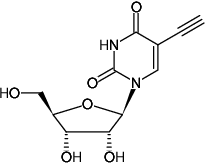5-Ethynyl-uridine
| Cat. No. | Amount | Price (EUR) | Buy / Note |
|---|---|---|---|
| CLK-N002-10 | 10 mg | 134,80 | Add to Basket/Quote Add to Notepad |

For general laboratory use.
Shipping: shipped at ambient temperature
Storage Conditions: store at -20 °C
store dry and under inert gas
Short term exposure (up to 1 week cumulative) to ambient temperature possible.
Shelf Life: 12 months after date of delivery
Molecular Formula: C11H12N2O6
Molecular Weight: 268.22 g/mol
Exact Mass: 268.07 g/mol
CAS#: 69075-42-9
Purity: ≥ 99 % (HPLC)
Form: solid
Color: white to off-white
Solubility: Up to 200 mM in 1 x PBS or water by heating the obtained suspension for 1 minute by 70 °C, less soluble in DMSO
Spectroscopic Properties: λmax 286 nm, ε 12.0 L mmol-1 cm-1 (Tris-HCl pH 7.5)
Applications:
RNA synthesis monitoring[1]
Description:
Ethynyl-labeled uridine (5-EU) can be used as a replacement for BrU (5-Bromo-uridine) to measure de novo RNA synthesis in proliferating cells. 5-EU is cell permeable and incorporates into nascent RNA instead of its natural analog uridine.
The resulting ethynyl-functionalized RNA can subsequently be detected via Cu(I)-catalyzed click chemistry that offers the choice to introduce a Biotin group (via Azides of Biotin) for subsequent purification tasks or a fluorescent group (via Azides of fluorescent dyes) for subsequent microscopic imaging[1].
Presolski et al.[2] and Hong et al.[3] provide a general protocol for Cu(I)-catalyzed click chemistry reactions that may be used as a starting point for the set up and optimization of individual assays.
Long term storage at < -20°C. If stored as recommended, Jena Bioscience guarantees optimal performance of this product for 12 months after date of delivery.
Related products:
BIOZ Product Citations:
Selected References:
[1] Jao et al. (2008) Exploring RNA transcription and turnover in vivo by using click chemistry. Proc. Nat. Acad. Sci. USA 105 (41):15779.
[2] Presolski et al. (2011) Copper-Catalyzed Azide-Alkyne Click Chemistry for Bioconjugation. Current Protocols in Chemical Biology 3:153.
[3] Hong et al. (2011) Analysis and Optimization of Copper-Catalyzed Azide-Alkyne Cycloaddition for Bioconjugation. Angew. Chem. Int. Ed. 48:9879.